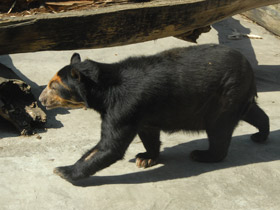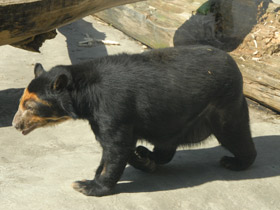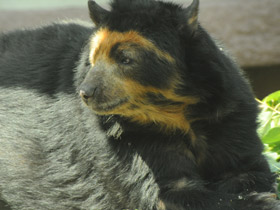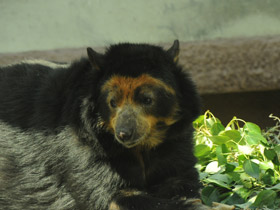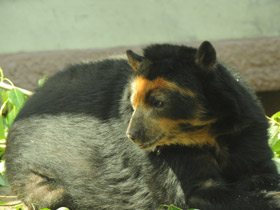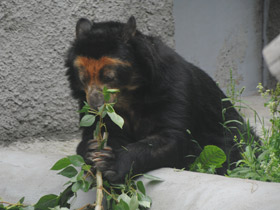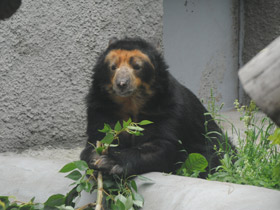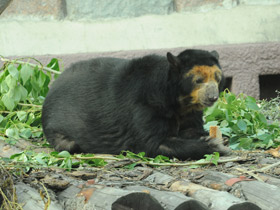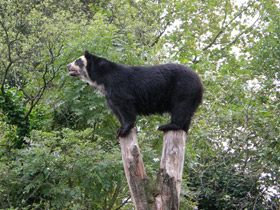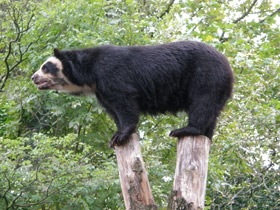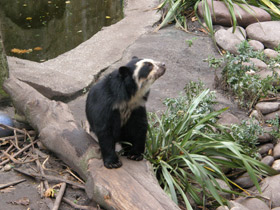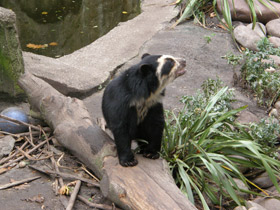The spectacled bear, the South American bear, Andean bear, Andean short-faced bear or mountain (Tremarctos ornatus)
The spectacled bear (Tremarctos ornatus), also known as the South American bear, Andean bear, Andean short-faced bear or mountain bear and locally as jukumari (Aymara and Quechua), ukumari (Quechua) or ukuku, is a species of bear native to the Andes Mountains in northern and western South America. It is the only living species of bear native to South America and the last remaining short-faced bear (subfamily Tremarctinae). Its closest relatives are the extinct Tremarctos floridanus and the giant short-faced bears (Arctodus and Arctotherium), which became extinct at the end of the Pleistocene about 12,000 years ago. Spectacled bear nutrition is primarily herbivorous, but occasionally exhibits carnivorous behaviour. The species is classified as Vulnerable by the IUCN due to habitat loss.
Tremarctos ornatus is a species of mammal in the family Ursidae. It is the only living species of its genus.
Names and etymology
Tremarctos ornatus is commonly known in English as "spectacled bear", in reference to the light colouration of its chest, neck and face, which may resemble spectacles in some individuals, or as "Andean bear" for its distribution throughout the Andes. The root trem- comes from a Greek word meaning "hole"; arctos is the Greek word for "bear". Tremarctos refers to an unusual hole in the humerus of the animal. Ornatus, Latin for "decorated", is a reference to the markings that give the bear its common English name.
Habitat and description
Tremarctos ornatus is the only representative of the bear family living in South America. It is on the verge of extinction and has therefore been included in the IUCN Red List. These bears have white or yellowish rings around the eyes (hence the name), which run down the muzzle and end on the chest, where they form patches of varying shape, size and colour (some bears have no patches). They can be individually identified by their distinctive pattern, unique to each bear (photo 3, 4, 5).
Distribution and habitat
Despite some rare spilling-over into eastern Panama, spectacled bears are mostly restricted to certain areas of northern and western South America. They can range in western Venezuela, Colombia, Ecuador, Peru, western Bolivia, and northwestern Argentina. Its elongated geographical distribution is only 200 to 650 km (120 to 400 mi) wide but with a length of more than 4,600 km (2,900 mi).
The species is found almost entirely in the Andes Mountains. Before spectacled bear populations became fragmented during the last 500 years, the species had a reputation for being adaptable, as it is found in a wide variety of habitats and altitudes throughout its range, including cloud forests, high-altitude grasslands, dry forests and scrub deserts. A single spectacled bear population on the border of Peru and Ecuador inhabited as great a range of habitat types as the world's brown bears (Ursus arctos) now occupy. The best habitats for spectacled bears are humid to very humid montane forests. These cloud forests typically occupy a 500 to 1,000 m (1,600 to 3,300 ft) elevational band between 1,000 and 2,700 m (3,300 and 8,900 ft) depending on latitude. Generally, the wetter these forests are the more food species there are that can support bears. Occasionally, they may reach altitudes as low as 250 m (820 ft), but are not typically found below 1,900 m (6,200 ft) in the foothills. They can even range up to the mountain snow line at over 5,000 m (16,000 ft) in elevation. Therefore, it is well known that bears use all these types of habitats in regional movements; however, the seasonal patterns of these movements are still unknown.
Nowadays, the distribution area of the Tremarctos ornatus is influenced by the human presence, mainly due to habitat destruction and degradation, hunting and fragmentation of populations. This fragmentation is mainly found in Venezuela, Colombia, Ecuador and Argentina. It represents several problems to this population because, first, their persistence is compromised if they are small, isolated populations, even without facing habitat lost or hunting. Second, the transformation of the landscape represents loss of availability of the type of habitats spectacled bears need. Third, fragmentation exposes bears to hunting and killing due to its accessibility.
Lifestyle and nutrition
Tremarctos ornatus leads a solitary lifestyle and comes out of hiding mainly at dusk and at night. It is the most herbivorous bear (after the great panda) of the whole family: it feeds on grass shoots, fruits and rhizomes, berries and tree bark (photos 6, 7, 8).
Tremarctos ornatus is very fond of the fruits of plants of the bromeliad family, and they sometimes constitute up to half of the animals' diet. These bears are excellent tree climbers. After climbing to the top of the trunk and finding abundant fruit, they sometimes settle in the tree for several days. In semi-deserts they feed on cacti and their fruits, sometimes appearing in the fields and feasting on corn cobs and sugar cane.
Tremarctos ornatus can include insects in its diet: its relatively narrow snout and long tongue allow it to penetrate deep into the destroyed homes of ants or termites and feed on them. When food is scarce, Tremarctos ornatus may eat rodents and birds, and in some cases even attack livestock. In times of extreme hunger, these peaceful animals occasionally prey on deer and guanacos. Spectacled bears do not hibernate in winter.
Reproduction
The weight of a newborn Tremarctos ornatus is 300-360g. The cubs develop faster than those of other bear species and, at 8 months, are fully independent and can leave their mother.
Threats
The Andean bear is threatened due to poaching and habitat loss. Poaching might have several reasons: trophy hunting, pet trade, religious or magical beliefs, natural products trade and conflicts with humans.
Conservation actions and plans
The IUCN has recommended the following courses for spectacled bear conservation: expansion and implementation of conservation land to prevent further development, greater species level research and monitoring of trends and threats, more concerted management of current conservation areas, stewardship programs for bears which engage local residents and the education of the public regarding spectacled bears, especially the benefits of conserving the species due to its effect on natural resources.

















